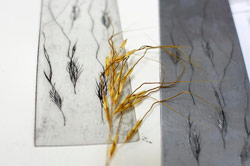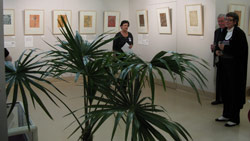Replant: a new generation of botanical art (2006)
Replant artists: Debra Wurrkidj, Fiona Hall, Irene Mungatopi, Judy Watson, Marita Sambono and Winsome Jobling.
Replant is an excursion through the eyes of six different artists into the remarkable world of plants in the tropical north of Australia. This exciting folio of limited edition etchings explores the unique characteristics of species that survive and prosper through the climatic extremes of monsoonal rains, dry weather and wild fires.
Gathering at Daly River, 230 kilometres southwest of Darwin in March 2006 the artists explored the scientific, cultural and social aspects of Indigenous plant species with traditional knowledge custodians and ethno botanist Glenn Wightman. Together they distilled ideas and visions in an acutely observed survey of Top End flora and environment. The group then returned to Darwin to the printmaking studio of master printmaker Basil Hall to resolve the work.
Replant reflects the traditional role of women as gatherers of food and holders of knowledge, combined with the rise of printmaking as a significant medium for Indigenous artists.
Replant was exhibited at George Brown Darwin Botanical Gardens August 2006 as part of the Darwin Festival and is supported the Australia Council for the Arts, NT Research and Innovation Board, Arts NT and Artback NT: Arts Development and Touring.
View the Replant artwork on the Online Gallery
The idea for Replant germinated during a conversation with the Director of the Northern Territory Herbarium in 2003. Dr Greg Leach spoke about cross-cultural and interdisciplinary research being undertaken at the Herbarium. The idea struck a chord and in March 2006 an eclectic group of artists, a botanist, printmakers and a photographer gathered together at Nauiyu on the Daly River with traditional knowledge custodians to share observations, knowledge, ideas and culture and make art.
The charm of the Replant project was the mysterious unravelling of knowledge and inspiration. The two-week journey began at the Northern Territory Herbarium, a meeting place of Western science and Indigenous plant culture. Our host Glenn Wightman is an ethno-botanist with 25 years experience in the Northern Territory and was an informative guide through protocols and knowledge systems, which interweave cultural and geographical boundaries.
From the Herbarium the group travelled three hours southwest from Darwin to Nauiyu community on the Daly River. The first few days were spent in the bush with Traditional Owners and making initial drawings and prints at Merrepen Art Centre. The research process was driven by the curiosity and creative exploration of the artists. Each drawing upon their cultural heritage, art practice and experience to filter new observations and information.
Glenn Wightman and traditional knowledge custodians Biddy Lindsay, Patricia Marrfurra and Marita Sambono shared their knowledge and observations as they led the artist group through the Daly River bushlands. Cultural stories, plant use and scientific knowledge were then distilled together on zinc plates in an acutely observed survey of flora and Top End environment.
Basil Hall and Jo Diggins from Basil Hall Editions in Darwin established a temporary studio at Merrepen Art Centre and set about facilitating the printmaking workshop. A creative and productive collaboration soon developed as artist came and went from field to studio.
Some of the artists began with soft ground impressions of plant material while others worked directly onto the plates. The workshop was both highly organised and flexible. Plate sizes were set to create a unified format for the work while the etching process formed visual links between the contrasting artistic styles. Basil and Jo worked tirelessly with each artist through the process of evaluating options and developing ideas. During the second week the artists and printers returned to Basil Hall Editions in Darwin and set about resolving images and proofing the etchings.
Protocols, cultural sensitivity and awareness were key elements of Replant. As in the plant world, the sharing of knowledge and cultural exchange grew only when the elements were right. The gathering of the six female artists reflects the traditional role of women as gatherers of food and holders of knowledge, combined with the rise of printmaking as a significant medium for Indigenous artists.
The artists were invited to participate in Replant on the basis of their art practice and come from a diverse range of cultural and stylistic backgrounds. The artists were Winsome Jobling from Darwin, Debra Wurrkidj from Maningrida, Marita Sambono from Nauiyu, Irene Mungatopi from the Tiwi Islands, Fiona Hall from Adelaide and Judy Watson from Brisbane.
Marita Sambono is well known for her paintings on canvas and silk, which are based strongly in the culture and customs of her country. Marita is also an experienced printmaker. Her images express an intimate knowledge of plants and bush tucker from her ancestral Ngan’gikurunggurr country. One of the works titled Fog Dreaming depicts the site of one of her grandmother’s dreamings. Marita does not remember her grandmother but the spiritual associations with country, culture and ancestry are fundamental to her work.
Darwin artist Winsome Jobling continually experiments with plant material in papermaking and art. Winsome has resided in Darwin for 26 years and has experimented with around 60 local plant species as material and fibre for paper. Her work incorporates watermarks or hidden images, which reference underlying constructions of ownership.
In Replant Winsome focused on spear grass as the seasonally dominant element in the Top End landscape. Replant occurred towards the end of the wet season when the spear grass was shedding millions of awned seeds across the savannah landscapes. After the wet season the ‘knock em down’ winds flatten the grass, which mulches the ground and provides nutrients for the plant and insect life. Later at the beginning of the wet, the seeds grow again providing cover for small animals and insects that inhabit the Top End in abundance.
Irene Mungatopi from Melville Island applied her finely tuned knowledge of the bush. Irene has paternal links to Jurrupi country (Jessie River area, Melville Island) and maternal links to Rangini, also on Melville; her skin group is Yarrinapila, red ochre, and her dreaming is nyarringari, the magpie goose.
“I made this etching of the green plum. It is called yankumwani in my language (Buchanania obovata in Western science). It grows in the bush on the Tiwi Islands where I come from. We walk along the bush at the end of the dry season and we see those plums hanging down. We eat them straight from the tree. They taste lovely. They have a pale flesh and a seed inside. We eat the flesh and throw the seed away.”
Deborah Wurrkidj also engaged in the subject of familiar bush-fruit food from her traditional country near Maningrida in west central Arnhem Land and reflected on her practise as a pandanus weaver and the teachings of her grandmother and grandfather and the sacred stories associated with the plants. Deborah’s deceased grandfather was a renowned fibre-craft artist who made large and complex fish traps, it is through this ancestral heritage that she has developed her skills and interest in fibre-crafts. Deborah’s interpretation of pandanus in her etching is purely from a weavers’ perspective.
Judy Watson drew broadly upon her ancestral connection with Waanyi country in northeast Queensland, women’s stories, events, and acute observations of the Top End environment.
With a spirit of rigorous investigation Judy collected a profusion of plants incorporating culturally significant species into spiritual symbols and historic references of land invasion and settlement. Her work is about fragility and resilience; emblematic images float against the power and chaos of nature. “You do not see things on their own” she observed, “but in an interconnected way with everything else. It is a whole intermeshing of life forms and the matrix of seeing through a landscape where everything is entwined and related”.
Fiona Hall continued her interest in Australian flora aligned with scientific and Aboriginal botanical systems and ecosystems. Plants have been a vitally important subject for Fiona Hall, who uses plants as complex metaphors for a wide range of interests and issues. “I am fascinated by the deep connections between things” she explained. “I have a love of botany but I am beginning to think about the way the botanical world is totally inseparable to all living things, even the soil. The environment affects the way plants look and how species change from one place to another. My interest in nests comes from that interconnection. I am intrigued by the architecture of nests but also how the insects interact with plants and live off plants and build their homes on the plants and become part of the plants. I have done very highly defined drawings in a botanical way, they are about the specimen being an integral part of the habitat.”
Our thanks to Artback NT: Arts Development and Touring, Australia Council for the Arts, Northern Territory Research and Innovation Board and Arts NT, Northern Territory Herbarium, Merrepen Artists and the Traditional Owners of the Nauiyu area, Basil Hall Editions, Monsoon Photographic Studio and Don White Framing.
By Angus Cameron October 2006
Coordinator of Replant and director of Nomad Art Productions in Darwin www.nomadart.com.au
Proudly supported by Artback NT: Arts Development and Touring.
The Replant National tour was proudly facilitated by Artback NT: Arts Development and Touring.

Education Kits
Introduction:
Replant is a project involving artists and scientists in the 'Top End' of Australia that took place in 2006. Students can explore Northern Australian flora through the eyes of seven artists as they share their observations of the hidden mysteries of plants, cultural stories, traditional knowledge and western science.
The Replant Education Kit is a downloadable resource available online as pdf files to print as required. The Education Kit has been designed to help students K – 12 and families appreciate and enjoy the Replant exhibition through activities and information appropriate to their age levels, experience and abilities. It can also be used for classroom activities.
Activities and information are divided into the following sections:
PROJECT NOTES:
The Project
The Art
The Science
LOCATION MAP:
PRE SCHOOL / LOWER PRIMARY:
Pre-visit activities
At the exhibition
Post-visit activities
UPPER PRIMARY / SECONDARY:
Pre-visit activities
Visiting the exhibition
Post-visit activities
UPPER SECONDARY:
Activity Sheet 1
Activity Sheet 2
Acknowledgements:
These materials were developed by Artback NT for use in schools and at exhibition venues. The activities may be reproduced for teaching purposes. Permission to reproduce any material for other purposes must be obtained from Artback NT.
Education Kit:
Angus Cameron, Nomad Art Productions
:
Photos from the event











